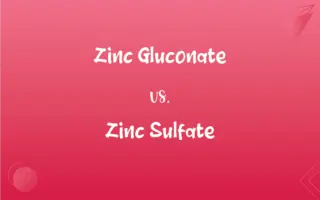Mild Steel vs. Stainless Steel: What's the Difference?
Edited by Janet White || By Harlon Moss || Published on December 30, 2023
Mild steel is a carbon steel with a low carbon content, whereas stainless steel is an alloy with chromium that resists corrosion.

Key Differences
Mild steel is known for its ductility due to its low carbon content, making it easy to weld and cut. Stainless steel, in contrast, includes chromium which gives it a higher resistance to corrosion and staining.
When it comes to cost, mild steel is generally more affordable compared to stainless steel, which is pricier due to its chromium content that enhances durability and corrosion resistance.
Mild steel is susceptible to rust when exposed to moisture, unlike stainless steel, whose chromium-rich composition forms a protective layer preventing rust and corrosion.
In terms of magnetism, mild steel is typically magnetic, which makes it useful in certain applications, whereas stainless steel can be either magnetic or non-magnetic depending on its structure and composition.
Mild steel is often preferred for large structural applications due to its strength and ease of fabrication, while stainless steel is favored in environments requiring corrosion resistance, like kitchen appliances and medical equipment.
ADVERTISEMENT
Comparison Chart
Composition
Low carbon content
Contains chromium, nickel, and other elements
Corrosion Resistance
Prone to rust
Highly resistant to corrosion
Cost
Generally more affordable
More expensive due to its alloying elements
Magnetism
Magnetic
Can be magnetic or non-magnetic
Preferred Use
Structural applications, construction
Applications requiring corrosion resistance
ADVERTISEMENT
Mild Steel and Stainless Steel Definitions
Mild Steel
Mild steel is a type of carbon steel with a low percentage of carbon.
The bridge was constructed using mild steel for its framework.
Stainless Steel
It is used in applications where both the strength of steel and corrosion resistance are required.
Stainless steel pipes are ideal for plumbing to prevent water damage.
Mild Steel
Mild steel is known for its high ductility and malleability.
Mild steel sheets were easily bent into desired shapes for the sculpture.
Stainless Steel
Stainless steel does not readily corrode, rust, or stain with water.
Kitchen sinks are often made of stainless steel for its long-lasting finish.
Mild Steel
It is a common form of steel, inexpensive and widely used.
Automobile bodies are often made from mild steel due to its affordability.
Stainless Steel
Stainless steel is an alloy containing chromium, known for its corrosion resistance.
Stainless steel utensils are popular due to their rust-resistant properties.
Mild Steel
Mild steel is weldable, making it ideal for various industrial applications.
The factory used mild steel in creating durable machinery parts.
Stainless Steel
Stainless steel is often used in medical instruments for its hygienic properties.
Surgical tools are made from stainless steel for sterilization purposes.
Mild Steel
It is less resistant to corrosion compared to other steel types.
The mild steel components required regular painting to prevent rust.
Stainless Steel
It can be highly polished, providing an attractive and clean appearance.
The stainless steel sculpture shone brilliantly in the museum.
Stainless Steel
Alternative spelling of stainless steel
FAQs
Can mild steel resist corrosion?
Mild steel is prone to rust and requires protective coatings.
What is mild steel?
Mild steel is a low carbon steel known for its ductility and weldability.
What is stainless steel?
Stainless steel is a steel alloy with chromium, known for its corrosion resistance.
What are common uses of stainless steel?
Stainless steel is used in kitchenware, medical instruments, and plumbing.
Is stainless steel easy to clean?
Yes, stainless steel is easy to clean and maintain.
Does stainless steel corrode in saline environments?
High-grade stainless steel resists corrosion, even in saline environments.
Is stainless steel magnetic?
Stainless steel can be magnetic or non-magnetic, depending on its grade.
How does the cost of mild steel compare to stainless steel?
Mild steel is generally more affordable than stainless steel.
What are common uses of mild steel?
Mild steel is used in construction, automotive, and structural applications.
How does mild steel react to moisture?
Mild steel can rust when exposed to moisture.
Is welding stainless steel different from welding mild steel?
Yes, welding stainless steel requires specific techniques and tools.
How is mild steel manufactured?
Mild steel is made by reducing the carbon content in iron.
Can mild steel withstand high temperatures?
Mild steel can withstand high temperatures but may lose strength.
How do you identify mild steel from stainless steel?
Mild steel is magnetic and corrodes easily, unlike stainless steel.
Can mild steel be used in outdoor applications?
Mild steel can be used outdoors but requires rust prevention measures.
Is stainless steel environmentally friendly?
Stainless steel is highly recyclable and considered environmentally friendly.
What are the different grades of stainless steel?
Stainless steel comes in various grades, like 304 and 316, differing in composition and properties.
Is stainless steel hypoallergenic?
Yes, most stainless steel is hypoallergenic, making it suitable for skin contact.
What makes stainless steel 'stainless'?
The chromium content in stainless steel forms a protective layer preventing rust.
Can mild steel be recycled?
Yes, mild steel is recyclable.
About Author
Written by
Harlon MossHarlon is a seasoned quality moderator and accomplished content writer for Difference Wiki. An alumnus of the prestigious University of California, he earned his degree in Computer Science. Leveraging his academic background, Harlon brings a meticulous and informed perspective to his work, ensuring content accuracy and excellence.
Edited by
Janet WhiteJanet White has been an esteemed writer and blogger for Difference Wiki. Holding a Master's degree in Science and Medical Journalism from the prestigious Boston University, she has consistently demonstrated her expertise and passion for her field. When she's not immersed in her work, Janet relishes her time exercising, delving into a good book, and cherishing moments with friends and family.































































